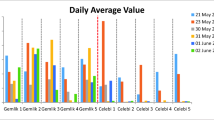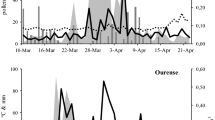Abstract
Olive is recognized as a crop with great impact in agricultural, socioeconomic, environmental and public health sectors. The last is becoming more important during recent years as consequence of the increase of the pollen allergy in south Europe prompted by the widespread Olea pollen allergic reactions. The aim of the study was to quantify, for the first time, the variations of the Ole e 1 allergen amount in Olea pollen grains from four cultivars in three regions of Portugal. How weather parameters can affect the allergen production was also assessed. The study was conducted in three olive producer areas of Portugal from 2010 to 2013, Santarém (Central), Elvas (Southeast) and Mirandela (Trás-os-Montes region, Northeast). Mature pollen of four different cultivars (Cobrançosa, Arbequina, Picual and Verdeal) was collected during the olive flowering season. Ole e 1 was quantified using specific 2-site antibody ELISA. Pollen of the olive groves at the boundary Olea bioclimatic distribution in the Mirandela registered the higher allergen content for all varieties in each study year. Arbequina was the variety that showed the lower Ole e 1 allergen concentration, whereas the higher content was registered for Cobrançosa. The main meteorological parameters that influenced the allergen Ole e 1 concentration in the pollen grains were the rainfall and temperatures related variables. The knowledge of the allergenicity in different olive cultivars is an important tool in the selection of the most adequate for planting as ornamental crop and to adjust the pollen extracts used for diagnosis or even immunotherapy.





Similar content being viewed by others
References
AAO. (2011). Agency for olive oil. Sector information, Ministry of Environment and Rural and Marine Environment of Government of Spain. Retrieved May 23, 2020, from http://www.magrama.gob.es/en/ministerio/funcionesestructura/organizacion-organismos/organismos-publicos/aao/.
Alche, J., M’rani-Alaoui, M., Castro, A., & Rodríguez-García, M. (2004). Ole e 1, the major allergen from olive (Olea europaea L.) pollen, increases its expression and is released to the culture medium during in vitro germination. Plant & Cell Physiology, 45, 1149–1157.
Alché, J. D., Castro, A. J., Jimenez-Lopez, J. C., Morales, S., Zafra, A., Hamman-Khalifa, A. M., et al. (2007). Differential characteristics of olive pollen from different cultivars: Biological and clinical implications. Journal of Investigational Allergology and Clinical Immunology, 17, 17–23.
Arilla, M. C., Eraso, E., Ibarrola, I., Algorta, J., Martínez, A., & Asturias, J. A. (2002). Monoclonal antibody-based method for measuring olive pollen major allergen Ole e 1. Annals of Allergy, Asthma & Immunology, 89, 83–89.
Asturias, J. A., Arilla, M. C., Gómez-Bayón, N., Martínez, J., Martínez, A., & Palacios, R. (1997). Cloning and expression of the panallergen profilin and the major allergen (Ole e 1) from olive tree pollen. The Journal of Allergy and Clinical Immunology, 100(3), 365–372.
Barber, D., de la Torre, F., Feo, F., Florido, F., Guardia, P., Moreno, C., et al. (2008). Understanding patient sensitization profiles in complex pollen areas a molecular epidemiological study. Allergy, 63, 1550–1558.
Barranco, D., Fernández-Escobar, R., & Rallo, L. (2008). El Cultivo del olivo (8a ed.). Madrid: Junta de Andalucía y Ediciones Mundi-Prensa.
Buters, J. T. M., Kasche, A., Weichenmeier, I., Schober, W., Klaus, S., Traidl-Hoffmann, C., et al. (2008). Year-to-year variation in release of Bet v 1 allergen from birch pollen: Evidence for geographical differences between west and south Germany. International Archives of Allergy and Immunology, 145(2), 122–130.
Buters, J. T. M., Thibaudon, M., Smith, M., Kennedy, R., Rantio-Lehtimäki, A., Albertini, R., et al. (2012). Release of Bet v 1 from birch pollen from 5 European countries. Results from the HIALINE study. Atmospheric Environment, 55, 496–505.
Buters, J. T. M., Weichenmeier, I., Ochs, S., Pusch, G., Kreyling, W., Boere, A. J., et al. (2010). The allergen Bet v 1 in fractions of ambient air deviates from birch pollen counts. Allergy, 65(7), 850–858.
Cabrera, M., Martinez-Cócera, C., Fernandez-Caldas, E., Carnés Sánchez, J., Boluda, L., Tejada, J., et al. (2002). Trisetum paniceum (wild oats) pollen counts and aeroallergens in the ambient air of Madrid, Spain. International Archives of Allergy and Immunology, 128, 123–129.
Camacho, I. (2017). Inhalants allergens in Portugal. International Archives of Allergy and Immunology, 172, 67–88.
Casanovas, M., Florido, F., de San Pedro, B. S., González, P., Martínez-Alzamora, F., Maranon, F., et al. (1997). Sensitization to Olea europaea: Geographical differences and discrepancies. Allergologia Immunopathology (Madrid), 25(4), 159–166.
D’Amato, G., Cecchi, L., Bonini, S., Nunes, C., Annesi-Maesano, I., Behrendt, H., et al. (2007). Allergenic pollen and pollen allergy in Europe. Allergy, 62, 976–990.
D’Amato, G., Holgate, S. T., Pawankar, R., Ledford, D. K., Cecchi, L., Al-Ahmad, M., et al. (2015). Meteorological conditions, climate change, new emerging factors, and asthma and related allergic disorders. A statement of the World Allergy Organization. World Allergy Organization Journal, 8, 25.
Dahl, A., Galan, C., Hajkova, L., Pauling, A., Sikoparija, B., Smith, M., et al. (2013). The onset, course, and intensity of the pollen season. In M. Sofiev & K. C. Bergmann (Eds.), Allergenic pollen. Dordrecht: Springer.
Fernández-Caldas, E., Carnés, J., Iraola, V., & Casanovas, M. (2007). Comparison of the allergenicity and Ole e 1 content of 6 varieties of Olea europaea pollen collected during 5 consecutive years. Annals of Allergy, Asthma & Immunology, 98, 464–470.
Fernández-González, D., Vega Maray, A. M., González Parrado, Z., Valencia Barrera, R. M., Gutierrez, P., De Nuntiis, P., et al. (2019). Are the profilins an important component in the atmosphere? Ole e 2-like panallergen. Aerobiologia, 35, 165–175.
Galán, C., Antunes, C., Brandao, R., Torres, C., Garcia-Mozo, H., Caeiro, E., et al. (2013). Airborne olive pollen counts are not representative of exposure to the major olive allergen Ole e 1. Allergy: European Journal of Allergy and Clinical Immunology, 68(6), 809–812.
Galán, C., García-Mozo, H., Vázquez, L., Ruiz, L., Díaz de la Guardia, C., & Trigo, M. M. (2005). Heat requirement for the onset of the Olea europaea L. pollen season in several sites in Andalusia and the effect of the expected future climate change. International Journal of Biometeorology, 49, 184–188.
García-Mozo, H., Orlandi, F., Galán, C., Fornaciari, M., Romano, B., Ruíz, L., et al. (2009). Olive flowering phenology variation between different cultivars in Spain and Italy: modelling analysis. Theoretical and Applied Climatology, 95, 385–395.
Hamman-Khalifa, A., Castro, A. J., Jiménez-López, J. C., Rodríguez-García, M. I., & Alché, J. D. (2008). Olive cultivar origin is a major cause of polymorphism for Ole e 1 pollen allergen. BMC Plant Biology, 8, 10.
INE. (2018). Superfície das principais culturas agrícolas (ha) por localização geográfica (Região agrária) e espécie. Portuguese National Statistical Institute, Accessed April 8th, 2019.
Martín-Puertas, C., Valero-Garcés, B. L., Mata, M. P., González-Sampériz, P., Bao, R., Moreno, A., et al. (2008). Arid and humid phases in southern Spain during the last 4000 years: The Zoñar Lake record, Córdoba. The Holocene, 18, 907–921.
Melo-Abreu, J. P., Barranco, D., Cordeiro, A. M., Tous, J., Rogado, B. M., & Villalobos, F. J. (2004). Modelling olive flowering date using chilling for dormancy release and thermal time. Agricultural and Forest Meteorology, 125(1–2), 117–127.
Morales, S., Castro, A. J., Jiménez-Lopez, J. C., Florido, F., Rodríguez-García, M. I., & Alché, J. D. (2012). A novel multiplex method for the simultaneous detection and relative quantitation of pollen allergens. Electrophoresis, 33(9–10), 1367–1374.
Oeo-Santos, C., Mas, S., Quiralte, J., Colas, C., Blanca, M., Fernandez, J., et al. (2018). A hypoallergenic polygalacturonase isoform from olive pollen is implicated in pollen–pollen cross-reactivity. International Archives of Allergy and Immunology, 177(4), 290–301.
Quiralte, J., Florido, F., Arias de Saavedra, J. M., Gómez, A., de San, Sáenz, Pedro, B., et al. (2002). Olive allergen-specific IgE responses in patients with Olea europaea pollinosis. Allergy, 57, 47–52.
Ribeiro, H. (2008). Previsão da Fenologia e Produtividade da Olea europaea L. Ph.D. thesis, FCUP.
Ribeiro, H., Morales, S., Salmerón, C., Cruz, A., Calado, L., Rodríguez-García, M. I., et al. (2013). Analysis of the pollen allergen content of twelve olive cultivars grown in Portugal. Aerobiologia, 29, 513–521.
San Segundo-Acosta, P., Oeo-Santos, C., Benedé, S., de Los Ríos, V., Navas, A., Ruiz-Leon, B., et al. (2019). Delineation of the olive pollen proteome and its allergenome unmasks cyclophilin as a relevant cross-reactive allergen. Journal of Proteome Research, 18(8), 3052–3066.
Sánchez-Mesa, J. A., Serrano, P., Cariñanos, P., Prieto-Baena, J. C., Moreno, C., Guerra, F., et al. (2005). Pollen allergy in Cordoba city: Frequency of sensitization and relation with antihistamine sales. Journal of Investigational Allergology and Clinical Immunology, 15(1), 50–56.
Sicard, P., Thibaudon, M., Besancenot, J. P., & Mangin, A. (2012). Forecast models and trends for the main characteristics of the Olea pollen season in Nice (southeastern France) over the 1990–2009 period. Grana, 51(1), 52–62.
Tang, W., Ezcurra, I., Muschietti, J., & McCormick, S. (2002). A cysteine-rich extracellular protein, LAT52, interacts with the extracellular domain of the pollen receptor kinase LePRK2. Plant Cell, 14, 2277–2287.
Tipping, M., & Bishop, C. (1999). Probabilistic principal component analysis. Journal of the Royal Statistical Society Series B (Statistical Methodology), 61, 611–622.
Van Ree, R., Cabanes-Macheteau, M., Akkerdaas, J., Milazzo, J. P., Loutelier-Bourhis, C., Rayon, C., et al. (2000). β (1,2)-xylose and α (1,3)-fucose residues have a strong contribution in IgE binding to plant glycoallergens. Journal of Biological Chemistry, 275, 11451–11458.
Villalba, M., Batanero, E., López-Otín, C., Sánchez, L. M., Monsalve, R. I., González de la Peña, M. A., et al. (1993). The amino acid sequence of Ole e I, the major allergen from olive tree (Olea europaea) pollen. European Journal of Biochemistry, 216, 863–869.
Villalba, M., Rodriguez, R., & Batanero, E. (2014). The spectrum of olive pollen allergens. From structures to diagnosis and treatment. Methods, 66(1), 44–54.
Vuletin Selak, G., Goreta Ban, S., & Perica, S. (2019). The effect of temperature on olive pollen germination. Acta Horticulturae, 1231, 49–54.
Acknowledgements
FEDER funds through the Operational Program Competitiveness Factors (COMPETE) and National funds through FCT – Foundation for Science and Technology in the Project PTDC/AGR-AAM/104562/2008. Institute of Earth Sciences (ICT) funds, under the Project COMPETE 2020 (UIDB/GEO/04683/2020) reference POCI-01-0145-FEDER-007690. Scholarship (SFRH/BDP/125686/2016) of M. Fernández-González. CITACA Strategic Partnership ED431E 2018/07 (Xunta de Galicia, Spain).
Author information
Authors and Affiliations
Corresponding author
Rights and permissions
About this article
Cite this article
Fernández-González, M., Ribeiro, H., Pereira, S.G. et al. Pollen Ole e 1 content variations in olive cultivars of different Portugal regions. Aerobiologia 37, 205–216 (2021). https://doi.org/10.1007/s10453-020-09688-y
Received:
Accepted:
Published:
Issue Date:
DOI: https://doi.org/10.1007/s10453-020-09688-y




